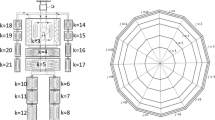Summary
Thermal conductance was subdivided into the component conductances of the appendages and torso using a heat transfer analysis for the deer mouse,Peromyscus maniculatus, and the white rabbit,Oryctolagus cuniculus. Our analysis was based on laboratory measurements of skin temperature and respiratory gas exchange made between air temperatures of 8 and 34°C for the deer mouse, and from published data for the white rabbit. Two series conductances to heat transfer for each appendage and torso were evaluated: (1) internal (h in), for blood flow and tissue conduction to the skin surface, and (2) external (h ex), for heat loss from the skin surface to the environment. These two series conductances were represented in a single, total conductance (h tot). The limit toh tot was set byh ex and was reached by the torsoh tot of both animals. The increase in torsoh tot observed with air temperature for the mouse suggests that a pilomotor change in fur depth occurred. A control ofh tot below the limit set byh ex was achieved by theh in of each appendage. Elevation of mouse thermal conductance (C) resulted from increases in feet, tail, and torsoh tot. In contrast, the rabbit showed no change in torsoh tot between 5 and 30°C and earh tot exclusively increasedC over these air temperatures. We suggest that the hyperthermia reported for the rabbit at 35°C resulted fromC reaching the physical limit set by torso and nearh ex. Thus the ear alone adjusted rabbitC, whereas the feet, tail, and the torso contributed to the adjustment of mouseC.
Similar content being viewed by others
Abbreviations
- Symbols:
-
Quantity Units
- A :
-
surface area m2
- C :
-
thermal conductance W m−2°C−1
- F :
-
fractional dimensionless
- \(\hat F\) :
-
configuration (view) factor dimensionless
- h :
-
conductance W m−2°C−1
- M :
-
mass g
- \(\dot Q\) :
-
heat flow rate W
- T :
-
temperature °C
- \(\dot V\) :
-
volume flow rate cm3 min−1 (STPD)
- a :
-
air
- app :
-
appendage
- c :
-
core
- cv :
-
convective
- E :
-
evaporative
- EC :
-
evaporative, cutaneous
- e :
-
ear
- ex :
-
external
- fe :
-
feet
- in :
-
internal
- M :
-
metabolic
- max :
-
maximum
- min :
-
minimum
- N :
-
net
- r :
-
radiative
- s :
-
skin
- t :
-
tail
- tor :
-
torso
- tot :
-
total
References
Bartholemew GA (1977) Body temperature and energy metabolism. In: Gordon MS (ed) Animal physiology: principles and adaptations. Macmillan, New York, pp 364–449
Cena K, Clark JA (1979) Transfer of heat through animal coats and clothing. In: Robertshaw D (ed) Environmental physiology III. Int Rev Physiol, vol 20. Univ Park Press, Baltimore, pp 1–42
Chappell MA, Holsclaw DS (1984) Effects of wind on thermoregulation and energy balance in deer mice (Peromyscus maniculatus). J Comp Physiol B 154:619–625
Edwards RM, Haines H (1978) Effects of ambient water vapor pressure and temperature on evaporative water loss inPeromyscus maniculatus andMus musculus. J Comp Physiol 128:177–184
Gonzalez RR, Kluger MJ, Hardy JD (1971) Partitional calorimetry of the New Zealand white rabbit at temperatures 5–35°C. J Appl Physiol 31:728–734
Grant RT (1963) Vasodilatation and body warming in the rat. J Physiol 167:311–317
Hart JS (1971) Rodents. In: Whittow GC (ed) Comparative physiology of thermoregulation, vol 2. Academic Press, New York, pp 1–149
Irving L (1956) Physiological insulation of swine as bareskinned mammals. J Appl Physiol 9:414–420
Kowalski GJ, Mitchell JW (1979) An analytical and experimental investigation of the heat transfer mechanisms within fibrous media. Am Soc Mech Eng Paper 79-WT/HT-40
Kreith F, Black WZ (1980) Basic heat transfer. Harper and Row, New York
Lynch WC, Adair ER, Adams BW (1980) Vasomotor thresholds in the squirrel monkey: effects of central and peripheral temperature. J Appl Physiol: Respir Environ Exercise Physiol 48:89–96
McAdams WH (1956) Heat transmission, 3rd edn. McGraw-Hill, New York
McArthur AJ (1980) Air movement and heat loss from sheep III. Components of insulation in a controlled environment. Proc R Soc Lond B 209:219–237
McArthur AJ (1981) Thermal resistance and sensible heat loss from animals. J Thermal Biol 6:43–47
Mitchell JW (1976) Heat transfer from spheres and other animal forms. Biophys J 16:561–569
Mount LE (1974) The concept of thermal neutrality. In: Monteith JL, Mount LE (eds) Heat loss from animals and man. Butterworths, London, pp 425–439
Porter WP, Busch RL (1978) Fractional factorial analysis of growth and weaning success inPeromyscus maniculatus. Science 202:907–910
Thauer R (1964) Circulatory adjustments to climatic requirements. In: Circulation. Am Physiol Soc, Washington, DC (Handbook of physiology, vol III, pp 1921–1966)
Wathen P, Mitchell JW, Porter WP (1971) Theoretical and experimental studies of energy exchange from jackrabbit ears and cylindrically shaped appendages. Biophys J 11:1030–1047
Wathen PW, Mitchell JW, Porter WP (1974) Heat transfer from animal appendage shapes — cylinders, arcs and cones. J Heat Trans, Series C 10:536–540
Wickler SJ (1980) Maximal thermogenic capacity and body temperatures of white-footed mice (Peromyscus) in summer and winter. Physiol Zool 53:338–346
Zar JH (1974) Biostatistical analysis. Prentice-Hall, Englewood Cliffs
Author information
Authors and Affiliations
Rights and permissions
About this article
Cite this article
Conley, K.E., Porter, W.P. Heat loss regulation: role of appendages and torso in the deer mouse and the white rabbit. J Comp Physiol B 155, 423–431 (1985). https://doi.org/10.1007/BF00684671
Accepted:
Issue Date:
DOI: https://doi.org/10.1007/BF00684671



